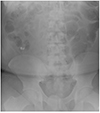Abstract
Coin batteries are often used in daily life devices and can be easily available. Children can swallow coin batteries, resulting in the need to go to hospital, but this is rare in adults. Adults generally eliminate the swallowed coin battery from the digestive system, unless they have congenital structural abnormalities of the digestive system or complications, such as postoperative stenosis. In this case, a 31-year-old man swallowed three coin batteries, approximately 0.4 cm in diameter emergent endoscopy was unable to find any batteries embedded in the ingested food. An attempt was made to rinse out the batteries by bowel preparation. During the hospital stay, the patient complained of acute abdominal pain and fever. In the abdominal CT scan, impaction of the coin battery into the appendix was confirmed. The patient underwent a laparoscopic appendectomy to prevent appendiceal perforation.
Figures and Tables
Fig. 1
(A, B) Erect and supine abdominal radiography image showed radio-opaque oval shape objects initially suspected to be coin batteries.

Fig. 2
Supine abdominal radiography image showed radio-opaque oval shape objects in the presumed cecum.

Fig. 3
(A) Colonoscopy showed two coin batteries in the cecum. (B) No coin battery was observed in the terminal ileum. (C) Two coin batteries were removed using a net snare. (D) No additional material was found after retrieving the batteries.

Fig. 4
Abdominopelvic computed tomography, axial (A) and coronal (B) view, both showed one coin battery remaining in the appendix (arrows).

Fig. 5
Gross specimen of the resected appendix. (A) Congestion and necrosis were progressing from the middle to distal appendix (circle). (B) Incision of the middle appendix revealed a coin battery. (C) Mucous tissue damage due to burning was observed at the site where the coin battery was impacted (arrow).

References
2. Maves MD, Carithers JS, Birck HG. Esophageal burns secondary to disc battery ingestion. Ann Otol Rhinol Laryngol. 1984; 93(4 Pt 1):364–369.

3. Rebhandl W, Steffan I, Schramel P, et al. Release of toxic metals from button batteries retained in the stomach: an in vitro study. J Pediatr Surg. 2002; 37:87–92.

4. Litovitz T, Butterfield AB, Holloway RR, Marion LI. Button battery ingestion: assessment of therapeutic modalities and battery discharge state. J Pediatr. 1984; 105:868–873.

5. Litovitz T, Schmitz BF. Ingestion of cylindrical and button batteries: an analysis of 2382 cases. Pediatrics. 1992; 89(4 Pt 2):747–757.
6. Samad L, Ali M, Ramzi H. Button battery ingestion: hazards of esophageal impaction. J Pediatr Surg. 1999; 34:1527–1531.

8. Sigalet D, Lees G. Tracheoesophageal injury secondary to disc battery ingestion. J Pediatr Surg. 1988; 23:996–998.

9. Bass DH, Millar AJ. Mercury absorption following button battery ingestion. J Pediatr Surg. 1992; 27:1541–1542.

10. Temple DM, McNeese MC. Hazards of battery ingestion. Pediatrics. 1983; 71:100–103.
11. Swallowed a button battery? Battery in the nose or ear? [Internet]. Washington, DC: National Capital Poison Center;2018. 06. cited 2019 Jan 3. Available from: https://www.poison.org/battery.
12. Litovitz T, Whitaker N, Clark L, White NC, Marsolek M. Emerging battery-ingestion hazard: clinical implications. Pediatrics. 2010; 125:1168–1177.

13. Kramer RE, Lerner DG, Lin T, et al. Management of ingested foreign bodies in children: a clinical report of the NASPGHAN Endoscopy Committee. J Pediatr Gastroenterol Nutr. 2015; 60:562–574.




 PDF
PDF ePub
ePub Citation
Citation Print
Print



 XML Download
XML Download